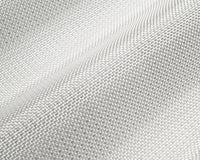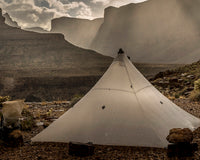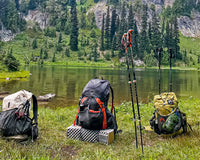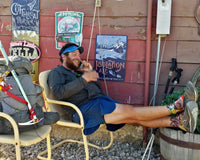
Anyone who’s backpacked a long distance knows there’s no perfect way to keep your gear dry. Pack covers are clunky, and blowing rain can come in from the sides. A waterproof pack is a good option, but they are usually made with Dyneema Composite Fabric and are very pricey. Pack liners are a simple, lightweight option that keeps the main-compartment contents of your pack dry.
I started my illustrious hiking career with a bulky pack cover that did a very good job collecting water in the bottom, soaking through the bottom of my pack. After a few trips, I switched to a trash compactor bag liner. These days, there are plenty of pack liner options. Liners can be as simple as a trash compactor bag, a clear plastic liner made for backpacking, or a fancier roll-top stuff sack. Pack liners also serve double duty to keep your wet items separated from your dry items. Did your tent get soaked overnight? When you’re packing up, leave your dry items in the pack liner, roll it shut, and throw your gross tent on top of the liner.
I tested a variety of pack liners over the past month. They all did their job keeping my gear dry, and were similarly easy to use. The main differences are in closure, materials, and price point. Here are the details.
Nylofume Pack Liner

MSRP: $2.24 for one (available in packs of 1, 2, or 3)
Size: Fits up to a 70-liter pack (20” x 36”)
Weight: 0.9 ounces
Materials: Nylofume
Pros: Extremely inexpensive, ultralight, durable. More structured bottom than some of the other plastic-bag styles. You can trim this bag to fit your smaller pack.
Cons: There’s no securing the top—you’re rolling and twisting like you would a trash compactor bag; won’t last as long as DCF or SilNylon.
I’ve never heard of this Nylofume before, and had to look up whether it was a material, brand, or smartly marketed combination of the two. After some internet digging, I’m still not quite sure. I did find out that nylofume bags are made of nylon polymer, and used to help protect food during fumigation. Lucky for the gram-and-dollar weenies out there, these are also for sale as pack liners. The bag I tested works splendidly in my 60L pack, and also fits in a pack up to 70 liters. In the end, I trimmed it to fit in my 45L bag (pictured), which is what I usually carry. This liner was totally waterproof once I did my usual twist-and-roll, and ended up feeling more durable than a trash compactor bag.
Sea to Summit UltraSil

MSRP: $34.95+
Size: 50L, 70L, 90L
Weight: 2.6 ounces
Materials: 30D Ultra-Sil CORDURA
Pros: Multiple levels of closure for waterproofing, can be used to carry and store items when not used as a pack liner. It also has increased durability over the “plastic bag” models.
Cons: There are less expensive options out there; weighs more than others on this list
Usage: This feels like one of the most protected liners on this list. I’ve used Sea to Summit dry bags and stuff sacks for years, and this one uses a similar roll-top / buckle closure. It stands out from others on the list thanks to a two-step closure. Two hook-and-loop tabs fold in to close the bag, then you roll the top closed and buckle it to complete the process. I have the 70L (pictured) which is almost comically large for my 45L pack. This liner comes in three sizes, so be sure to get the one that fits your bag the best. This liner’s finish made it easy to pull in and out of my bag, even when it was crammed full.
Mountain Laurel Designs Cuben Fiber DCF Liner

MSRP: $100 for 2-pack (one small and one large)
Size: 40L, 60L
Weight: 2.2 ounces
Materials: Dyneema Composite Fabric (DCF)
Pros: Lightweight, ultra-durable, snug fit, wide opening for gear
Cons: The obvious downside is the price of this liner compared to literally everything else on this list.
This is the only DCF liner on this list, and it’s the first one I tested. DCF is the gold standard for ultralight, durable, waterproof outdoor gear, and this liner is no exception. If you’re willing to spring for it, opting for a DCF bag is never a bad splurge. These bags have structured bottoms, fit smoothly into a pack, and have a secure roll-top closure with a buckle. Like the Sea to Summit liner, I’ve been storing gear in this liner when I’m not using it for backpacking. The buckles are lightweight and small, but easy to use with cold fingers, and I was able to get at least two rolls of the roll-top closure even with a pretty full gear haul.
Mountain Laurel Designs also sells a pack liner bag for $5, which is your very basic clear plastic bag.
Gossamer Gear Clear Waterproof Pack Liner

MSRP: $5 (pack of 2)
Size: 48L
Weight: 1.2 ounces|
Materials: Polyethylene film
Pros: Extremely inexpensive, simple, fits small packs best (35-50L)
Cons: One of the less durable on this list; felt somewhat small for my gear. Would have liked to be able to roll the top more.
These clear liners are great for one long trip, but I don’t know if they’d last much longer than that. I’d recommend these for people with smaller pack sizes, as I didn’t feel like I was able to get enough “rolls” in the opening and tuck it under for total waterproofing. It kept my gear dry in moderate rain, but I don’t know if I’d trust it with total pack saturation. For reference, I have a 45L pack. If you’re going to get a clear plastic bag liner, the Nylofume is a larger, somewhat more sturdy option for the same price.
Trash Compactor Bag

MSRP: $11 for pack of 5
Size: 18 gallons (68L)
Weight: 1.4 ounces
Materials: Plastic
Pros: Can be found at almost any generic store, inexpensive, durable, large capacity
Cons: Comes in packs of 5-10, so you’ll have to find people to share with
This is the OG hiker trash waterproof pack liner. The standard size fits an 18-gallon trash can, which translates to fitting a 68L pack. My trash compactor bag lasted over 1,000 miles of wet hiking, and had plenty of capacity to roll it down multiple times to keep my gear protected. If you’re going this route, be sure to get the compactor bag and not a regular trash bag. Trash compactor bags are different than standard trash bags in that they are far more durable, and have wide mouths instead of drawstrings.
















14 comments
Kingers
Sea to SDummit liners fail fast, seam seal peels away as doe the proofing film. Ortlieb ones are heavy but actually reliable.
Great Canadian Trails
I can understand your frustration and while it boiled over in this case. I probably would have reacted the same way. I run a hiking website in Canada and people are always stealing our titles, keywords, article ideas, and photos too. GearJunkie.com is the worst. I don’t think readers understand how lawless the big sites are. Kudos to you for manning up and apologizing though. By the way, I love your website. It really is the best backpacking site out there by a mile. Nothing comes close to the expertise you share. You made my IAT thru-hike a success.
Philip Werner
Maggie – I was out of line there. My apologies. So many people do copy my content, photos, and article titles that I shot off my mouth prematurely why I saw that title come through in Lloyds email.
Maggie Slepian
Oooooohhhhh Philip this industry is way too small to be accusing me of plagiarizing your pack liner roundup.
If you think I need to reference someone else’s review of pack liners (PACK LINERS!) to write my own 800-word comparison post, you need to rethink your own research strategies. I wish I could say I had ever been to your website or knew your pack liner roundup existed, but I have never felt the need to reference your site or find inspiration on pack liners (again… dude, it’s pack pack liners) from other sources. I would love to fight with you in the comments about this, but I didn’t know this ridiculous accusation existed until now. I would suggest you find something legitimate to accuse people of, as there is plenty to be upset about right now.
But pack liners? Seriously? You didn’t invent the riveting pack liner comparison, I hate to break it to you. Go sit down. And never accuse me of plagiarizing again.
Eric B.
Not a fan of pack liners. I use a very light ripstop silnylon pack cover and a few dry bags like my Sea to Summit pump sack that does double duty for pumping my REI FLASH Insulated air mattress and holding my clothes. At 9,000 ft. I NEED that pump sack!
So here’s a contrarian view of pack liners. BUT I do use them for canoe camping in case of an upset in rapids.
Amy Hatch
Paul, thanks for your note. We actually did reach out to Zpacks to include them as well, but they’re so swamped this summer that they couldn’t swing getting one out — totally understandable, but do appreciate you chiming in with your vote of confidence in them!
Ben Hancock
Philip, can you guess who won’t be using your affiliate links anymore?
Paul Richey
Philip,
What, you think you’re the only one that can review gear. I thought is was a good and thoughtful review.
I will add that my daughter and I just finished the Colorado Trail and used the Z Packs dyneema pack liners. Similar to the MLD reviewed here. Fantastic, and well worth the money.
Paul
Lloyd Vogel
Bummer that’s how you see if Philip. As a long time reader and admirer of your site, it is rather absurd of you to insinuate that you own the right to compare/review/critic products or collections of products. Maggie (an extremely experienced backpacker and writer) wrote her own opinions on products she’s used and tested extensively. Is there product overlaps between the articles? Sure. Will all “best quilt” articles probably include some mixing of products from Katabatic, EE, Nunatak, UGQ and HG? Yup. To call it “plagiarism” for comparing some similar best selling/most popular options is ridiculous.
You wrote an article called “Do You Need Trekking Poles for Backpacking?” Were you the first to write on that topic? Were all of those ideas previously unheard on the internet? Were you the first person to publish an article on “How to Find a Good Backpacking Campsite?” Were each of those tidbits undiscoverable revelations to the ultralight community? Of course not. Does that mean you plagiarized? Of course not… it was simply your opinions on a topic of interest. Just like a “Best Pack Liner for Lightweight Backpacking” article.
Love what you do over at Section Hiker… but internet trolling? Not a great look…
Andy Sargent
Philip, I read both articles, and Maggie clearly tested the products herself and her writing is clearly her own. The fact that she reviewed three products that we’re in your review seems irrelevant since they happen to be three obvious, widely used options that most experienced backpackers would already know about. I agree with James: “You did not invent the comparison of items for consumer purchase.” And to accuse a fellow writer in your industry of plagiarism so casually is poor form and just hurts your brand. As a long-time reader of your excellent website (and someone who always tries to buy products using your affiliate links), I would hope you’d either delete your comment or apologize.
james burial
Philip, that’s just silly. Reviewing similar items for an article is not plagiarism. It’s opinion. It’s what reviewers do. You did not invent the comparison of items for consumer purchase. This comes off petty and self-important.
Ed Philippe
Philip I genuinely love your site and refer to it often. But I have to agree with Curtis on this one. Gear, clothing, lists, etc. is reviewed and compared on countless websites and I for one appreciate the redundancy so as to get a variety of opinions on same or similar products. If the redundancy were eliminated, I’d only get one opinion on any given item and 3/4’s of the outdoor websites would shut down. This article was very helpful, as was yours.
Curtis Carmack
Philip, plagiarism is copying the words, not the idea. That was a bit harsh.
Philip Werner
I suppose plagiarism is the highest form of flattery.
https://sectionhiker.com/5-backpack-liners-compared/